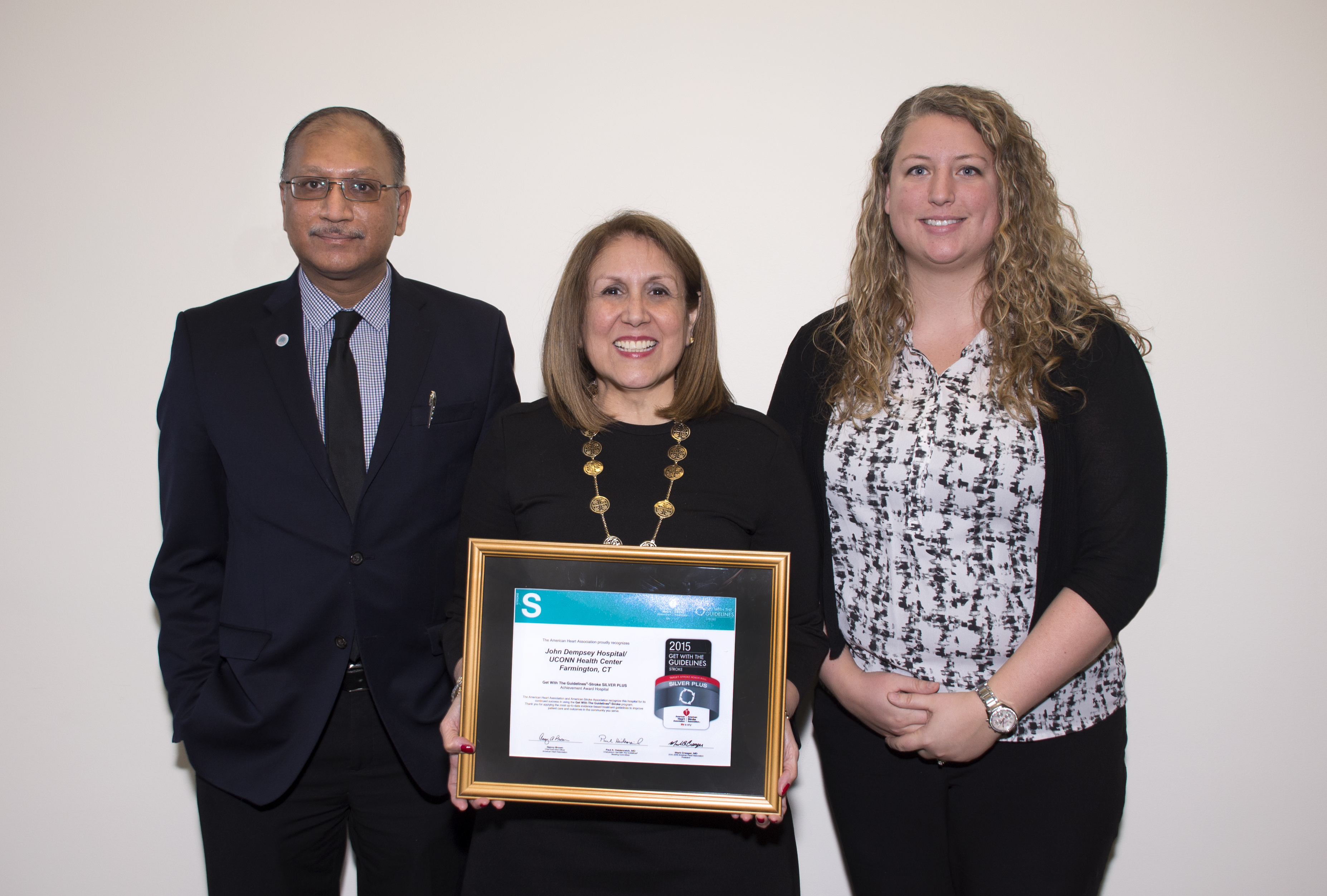UConn Health has won recognition from the American Heart Association and the American Stroke Association for its stroke team’s commitment to quality care for patients.
The Get With The Guidelines®-Stroke Silver Plus Quality Achievement Award with Target: StrokeSM Honor Roll award recognizes UConn John Dempsey Hospital’s commitment and success ensuring that stroke patients receive the most appropriate treatment according to nationally recognized, research-based guidelines based on the latest scientific evidence.
“This award represents the collaborative work of many clinicians,” says hospital CEO Anne Diamond. “Starting in the field with our EMS team, the doctors and nurses in the Emergency Department, the pharmacists, radiology team and then the doctors and nurses and all of the staff in the intensive care units.”
To receive the Silver Plus Quality Achievement Award, hospitals must achieve 85 percent or higher adherence to all Get With The Guidelines-Stroke achievement indicators for at least 12 consecutive months and during the same period achieve 75 percent or higher compliance with five of eight Get With The Guidelines-Stroke Quality measures.
“UConn Health delivers individualized quality stroke care by adhering to the latest recommendations and guidelines by AHA and The Joint Commission,” says Dr. Sanjay Mittal, UConn Health neurologist and Stroke Center director.
To qualify for the Target: Stroke Honor Roll, hospitals must meet quality measures developed to reduce the time between the patient’s arrival at the hospital and treatment with the clot-buster tissue plasminogen activator, or tPA, the only drug approved by the U.S. Food and Drug Administration to treat ischemic stroke. If given intravenously in the first three hours after the start of stroke symptoms, tPA has been shown to significantly reduce the effects of stroke and lessen the chance of permanent disability. John Dempsey Hospital earned the award by meeting specific quality achievement measures for the diagnosis and treatment of stroke patients at a set level for a designated period.
These quality measures are designed to help hospital teams provide the most up-to-date, evidence-based guidelines with the goal of speeding recovery and reducing death and disability for stroke patients.
“It takes a village to care for a stroke patient,” Diamond says. “Here at UConn’s John Dempsey Hospital we are a fine-tuned clinical operation taking into consideration even the smallest details in the care of our stroke patients to ensure that we diagnose and treat within a very tight window, which is best for optimal recovery. I am so proud that our team has achieved this award within the first year of our stroke center designation. Congratulations to Dr. Mittal and all those caring for our patients!”
For providers, Get With The Guidelines-Stroke offers quality improvement measures, discharge protocols, standing orders and other measurement tools. Providing hospitals with resources and information that make it easier to follow treatment guidelines can help save lives and ultimately reduce overall healthcare costs by lowering readmission rates for stroke patients.
For patients, Get With The Guidelines-Stroke uses the “teachable moment,” the time soon after a patient has had a stroke, when they learn how to manage their risk factors while still in the hospital and recognize the F.A.S.T. warning signs of a stroke.
“We are pleased to recognize John Dempsey Hospital for their commitment to stroke care,” says Dr. Deepak L. Bhatt, national chairman of the Get With The Guidelines steering committee, executive director of Interventional Cardiovascular Programs at Brigham and Women’s Hospital, and professor of medicine at Harvard Medical School. “Studies have shown that hospitals that consistently follow Get With The Guidelines quality improvement measures can reduce length of stay and 30-day readmission rates and reduce disparities in care.”
According to the American Heart Association/American Stroke Association, stroke is the number five cause of death and a leading cause of adult disability in the United States. On average, someone suffers a stroke every 40 seconds; someone dies of a stroke every four minutes; and 795,000 people suffer a new or recurrent stroke each year.



